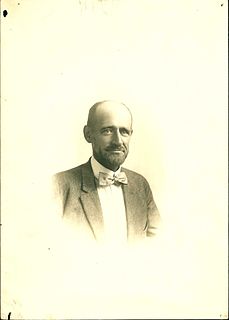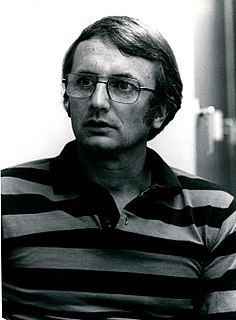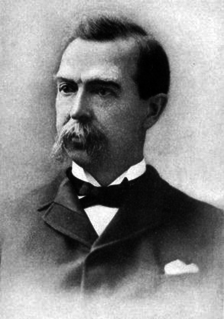
John Torrey was an American botanist, chemist, and physician. Throughout much of his career, he was a teacher of chemistry, often at multiple universities, while he also pursued botanical work, focusing on the flora of North America. His most renowned works include studies of the New York flora, the Mexican Boundary, the Pacific railroad surveys, and the uncompleted Flora of North America.

Nathaniel Lord Britton was an American botanist and taxonomist who co-founded the New York Botanical Garden in the Bronx, New York.

George Valentine Nash was an American botanist. He was the Head Gardener and Curator of the Plantations at the New York Botanical Garden, for whom he did field work in the Bahamas, South Florida and Haiti.

Henry Allan Gleason (1882–1975) was an American ecologist, botanist, and taxonomist. He was known for his endorsement of the individualistic or open community concept of ecological succession, and his opposition to Frederic Clements's concept of the climax state of an ecosystem. His ideas were largely dismissed during his working life, leading him to move into plant taxonomy, but found favour late in the twentieth century.

Elmer Drew Merrill was an American botanist and taxonomist. He spent more than twenty years in the Philippines where he became a recognized authority on the flora of the Asia-Pacific region. Through the course of his career he authored nearly 500 publications, described approximately 3,000 new plant species, and amassed over one million herbarium specimens. In addition to his scientific work he was an accomplished administrator, college dean, university professor and editor of scientific journals.
The Botanical Society of America (BSA) represents professional and amateur botanists, researchers, educators and students in over 80 countries of the world. It functions as a United States nonprofit 501(c)(3) membership society.

Eugene Pintard Bicknell was an American botanist and ornithologist.
Gertrude Simmons Burlingham was an early 20th-century mycologist best known for her work on American Russula and Lactarius and pioneering the use of microscopic spore features and iodine staining for species identification.

Elizabeth Gertrude Britton was an American botanist, bryologist, and educator. She and her husband, Nathaniel Lord Britton played a significant role in the fundraising and creation of the New York Botanical Garden. She was a co-founder of the predecessor to the American Bryological and Lichenological Society. She was an activist for protection of wildflowers, inspiring local chapter activities and the passage of legislation. Elizabeth Britton made major contributions to the literature of mosses, publishing 170 papers in that field.

Anna Murray Vail was an American botanist and first librarian of the New York Botanical Garden. She was a student of the Columbia University botanist and geologist Nathaniel Lord Britton, with whom she helped to found the New York Botanical Garden.
John Hendley Barnhart was an American botanist and author, specializing in biographies of botanists.
Henry Hurd Rusby (1855–1940) was an American botanist, pharmacist and explorer. He discovered several new species of plants and played a significant role in founding the New York Botanical Garden and developing research and exploration programs at the institution. He helped to establish the field of economic botany, and left a collection of research and published works in botany and pharmacology.
George Hill Mathewson Lawrence was an American botanist, writer and Professor of Botany. He helped establish the 'Liberty Hyde Bailey Hortorium', the Hunt Botanical Library and the Huntia journal. He was also an avid book collector,.

Emily Lovira Gregory (1840–1897) was an American botanist born in Portage, New York. She began her educational career by receiving her Bachelor's of Arts from Cornell University in 1881, later earning a Ph.D. at the University of Zurich. This made her one of the first American women to earn a doctoral degree from a university in Europe. Gregory often found it difficult to find paid academic positions. She often would take on the unpaid positions because she could support herself. From 1890 to 1895 at the University of Pennsylvania and Barnard College she worked as a teaching fellow and lecturer respectively. Gregory was the first woman elected to the American Society of Naturalists in 1886.

Lowell Fitz Randolph was an American scientist, in the field of genetics, botany and horticulture. He was a Cornell University graduate who became Professor of Botany and was also employed as an associate cytologist for the United States Department of Agriculture. He was also an avid iris collector and wrote a book on the Iris genus. He carried out important research into plant chromosomes of iris, orchid genus and corn plants. He was sometimes known as "Fitz" by his many friends and associates.

Vicki Ann Funk was an American botanist and curator at the Smithsonian's National Museum of Natural History, known for her work on members of the composite family (Asteraceae) including collecting plants in many parts of the world, as well as her synthetic work on phylogenetics and biogeography.
Willard Webster Eggleston was an American botanist, employed by the United States Department of Agriculture Bureau of Plant Industry. He graduated from Dartmouth College in 1891 with a Bachelor of Science degree. In his work on the taxonomy of Crataegus, now known to be complicated by apomixis, polyploidy, and hybridization, he aimed to simplify, counteracting the proliferation of species names that other botanists had produced.

George Newton Best was an American bryologist, expert on moss taxonomy, and second president of the Sullivant Moss Society.

Scott Alan Mori was a swiss and american botanist and plant collector. He specialized in the systematics and ecology of neotropical Lecythidaceae and Amazonian and Guianian floristics.

Timothy Field Allen was an American physician and botanist.













